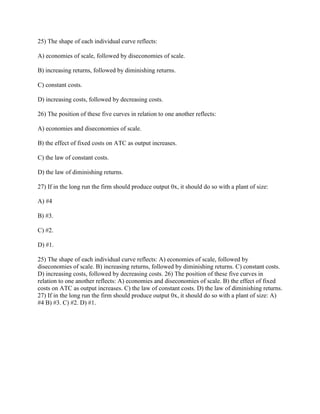25) The shape of each individual curve reflects- A) economies of scale.docx
25) The shape of each individual curve reflects: A) economies of scale, followed by diseconomies of scale. B) increasing returns, followed by diminishing returns. C) constant costs. D) increasing costs, followed by decreasing costs. 26) The position of these five curves in relation to one another reflects: A) economies and diseconomies of scale. B) the effect of fixed costs on ATC as output increases. C) the law of constant costs. D) the law of diminishing returns. 27) If in the long run the firm should produce output 0x, it should do so with a plant of size: A) #4 B) #3. C) #2. D) #1. 25) The shape of each individual curve reflects: A) economies of scale, followed by diseconomies of scale. B) increasing returns, followed by diminishing returns. C) constant costs. D) increasing costs, followed by decreasing costs. 26) The position of these five curves in relation to one another reflects: A) economies and diseconomies of scale. B) the effect of fixed costs on ATC as output increases. C) the law of constant costs. D) the law of diminishing returns. 27) If in the long run the firm should produce output 0x, it should do so with a plant of size: A) #4 B) #3. C) #2. D) #1. Solution 25) The shape of each individual curve reflects: B) increasing returns, followed by diminishing returns. Shape of each individual curve shows that first firm faces the increasing return in short run and then if firm keeps on adding the output, then average cost would start incrasing or diminishing return would be seen. 26) The position of these five curves in relation to one another reflects: A) economies and diseconomies of scale. Different curves shows the economies and diseconomics of scale since in the long run, firm would face the increasing cost if it increases the output beyond the capacity. 27) If in the long run the firm should produce output 0x, it should do so with a plant of size: C) #2. Average cost is minimum when firm goes with second plant hence correct option is (C) .

Empfohlen
Empfohlen
Weitere ähnliche Inhalte
Ähnlich wie 25) The shape of each individual curve reflects- A) economies of scale.docx
Ähnlich wie 25) The shape of each individual curve reflects- A) economies of scale.docx (20)
Mehr von todd621
Mehr von todd621 (9)
Kürzlich hochgeladen
Kürzlich hochgeladen (20)
25) The shape of each individual curve reflects- A) economies of scale.docx
- 1. 25) The shape of each individual curve reflects: A) economies of scale, followed by diseconomies of scale. B) increasing returns, followed by diminishing returns. C) constant costs. D) increasing costs, followed by decreasing costs. 26) The position of these five curves in relation to one another reflects: A) economies and diseconomies of scale. B) the effect of fixed costs on ATC as output increases. C) the law of constant costs. D) the law of diminishing returns. 27) If in the long run the firm should produce output 0x, it should do so with a plant of size: A) #4 B) #3. C) #2. D) #1. 25) The shape of each individual curve reflects: A) economies of scale, followed by diseconomies of scale. B) increasing returns, followed by diminishing returns. C) constant costs. D) increasing costs, followed by decreasing costs. 26) The position of these five curves in relation to one another reflects: A) economies and diseconomies of scale. B) the effect of fixed costs on ATC as output increases. C) the law of constant costs. D) the law of diminishing returns. 27) If in the long run the firm should produce output 0x, it should do so with a plant of size: A) #4 B) #3. C) #2. D) #1.
- 2. Solution 25) The shape of each individual curve reflects: B) increasing returns, followed by diminishing returns. Shape of each individual curve shows that first firm faces the increasing return in short run and then if firm keeps on adding the output, then average cost would start incrasing or diminishing return would be seen. 26) The position of these five curves in relation to one another reflects: A) economies and diseconomies of scale. Different curves shows the economies and diseconomics of scale since in the long run, firm would face the increasing cost if it increases the output beyond the capacity. 27) If in the long run the firm should produce output 0x, it should do so with a plant of size: C) #2. Average cost is minimum when firm goes with second plant hence correct option is (C)